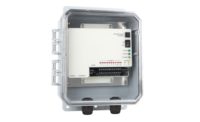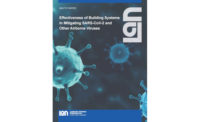· Use available tools and services to be proactive in monitoring your building. Use a building automation system, if available, to monitor your building and consider remote monitoring to give you reports of problems before they escalate.
· Monitor facilities to ensure that no warm, stagnant water is present as it can provide an environment conducive to the growth of problematic microbes such asLegionella, the cause of Legionnaire’s Disease.
· Monitor areas including cooling towers, pooled water on roofs, or clogged drains that can harbor unhealthy contaminants that can be introduced into the building and circulated by the air distribution systems into the occupied spaces.
· One simple upgrade facilities can implement is to replace air filter types with a higher efficiency filter. As filter efficiency increases, typically their resistance to air flow also increases. Always check to be sure the fan system can handle the resistance being imposed by the filters and other components in the system. Also, select replacement filters based on the specific particles you intend to collect. Viral droplets or droplet nuclei of influenza, for instance, are very small but are typically surrounded by a mucus shell making them much larger and easier to remove.
· It is necessary to re-evaluate how and when filters should be changed. Rather than via a simple schedule, it may be more prudent to measure the pressure drop through filter banks and set up basic performance metrics to determine the best model for filter changes.
· Simple measures are the first line of defense. Technicians should wear cut-resistant gloves when performing filter changes or basic maintenance to air dampers and commonly exposed system components. Also, properly fit respirators to ensure that the risk of exposure while working above the ceiling or in poorly ventilated areas is minimized.
· A common service and maintenance procedure is to verify correct outside air intake dampers settings and operation. Trane recommends that most commercial spaces operate at a slightly positive pressure relative to the outdoors to reduce the likelihood of contaminants infiltrating into the occupied areas.
· Check and validate restroom and other critical area exhaust fans to assure that they are removing contaminants from the building before they become mixed with the indoor air. Perform preventive maintenance on small exhaust fans to ensure they have not accumulated dirt, reducing their effectiveness.
· Provide staff with basic training and increase overall awareness about the risks of influenza exposure, the likely ways to contract the virus and the preventative measures that have been proven to work. Access details on the US Centers For Disease Control website (CDC - Seasonal Influenza - 2010-2011 Flu Season, link at bottom). In addition to increasing reducing exposure to other harmful airborne particles, conduct formal safety training of staff technicians and subcontract workers to reduce risk of injury while conducting maintenance on your building mechanical systems.
· As determined by the CDC, direct contact is the most common pathway for the spread of disease. Communicate influenza safety tips and precautions to all building departments – especially those whose primary function includes occupancy of guests, visitors and the general public.
· Encourage handwashing among all staff. If possible, add hand cleaner and hand sanitizer supplies at air handler locations, equipment controls, railings and access doors.
Additional Resources
There are many resources to provide details and more complete planning recommendations including:
· IFMA Foundation’s Pandemic Preparedness Manual (http://www.ifmafoundation.org/pandemic.pdf).
· The Center for Disease Control and Prevention (www.cdc.gov).
· The Federal Emergency Management Agency (www.fema.org).






